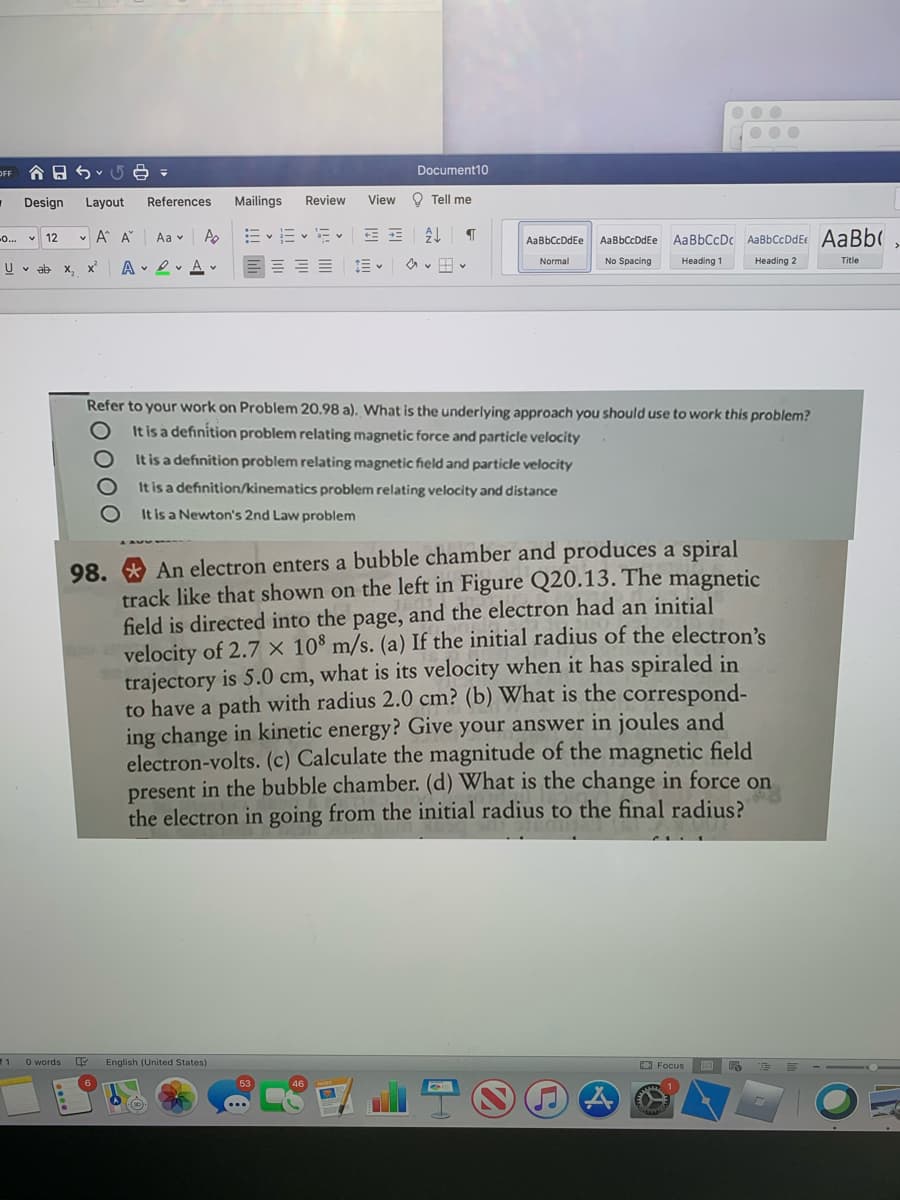98. * An electron enters a bubble chamber and produces a spiral track like that shown on the left in Figure Q20.13. The magnetic field is directed into the page, and the electron had an initial velocity of 2.7 x 108 m/s. (a) If the initial radius of the electron's trajectory is 5.0 cm, what is its velocity when it has spiraled in to have a path with radius 2.0 cm? (b) What is the correspond- ing change in kinetic energy? Give your answer in joules and electron-volts. (c) Calculate the magnitude of the magnetic field present in the bubble chamber. (d) What is the change in force on the electron in going from the initial radius to the final radius?
98. * An electron enters a bubble chamber and produces a spiral track like that shown on the left in Figure Q20.13. The magnetic field is directed into the page, and the electron had an initial velocity of 2.7 x 108 m/s. (a) If the initial radius of the electron's trajectory is 5.0 cm, what is its velocity when it has spiraled in to have a path with radius 2.0 cm? (b) What is the correspond- ing change in kinetic energy? Give your answer in joules and electron-volts. (c) Calculate the magnitude of the magnetic field present in the bubble chamber. (d) What is the change in force on the electron in going from the initial radius to the final radius?
Principles of Modern Chemistry
8th Edition
ISBN:9781305079113
Author:David W. Oxtoby, H. Pat Gillis, Laurie J. Butler
Publisher:David W. Oxtoby, H. Pat Gillis, Laurie J. Butler
Chapter1: The Atom In Modern Chemistry
Section: Chapter Questions
Problem 16P: In the problem 15 above, what is vy , the y-component of the electron’s velocity, when it has...
Related questions
Question

Transcribed Image Text:OFF
合日らv5e -
Document10
Design
Layout
References
Mailings
Review
View O Tell me
v A A
E vE v E v
AaBbCcDc AaBbCcDdE AaBb(
-.. v 12
Aa v
AaBbCcDdEe
AaBbCcDdEe
Normal
No Spacing
Heading 1
Heading 2
Title
U v ab
X,
A 2v A v
Refer to your work on Problem 20.98 a). What is the underlying approach you should use to work this problem?
It is a definition problem relating magnetic force and particle velocity
It is a definition problem relating magnetic field and particle velocity
It is a definition/kinematics problem relating velocity and distance
It is a Newton's 2nd Law problem
98. * An electron enters a bubble chamber and produces a spiral
track like that shown on the left in Figure Q20.13. The magnetic
field is directed into the page, and the electron had an initial
velocity of 2.7 × 10° m/s. (a) If the initial radius of the electron's
trajectory is 5.0 cm, what is its velocity when it has spiraled in
to have a path with radius 2.0 cm? (b) What is the correspond-
ing change in kinetic energy? Give your answer in joules and
electron-volts. (c) Calculate the magnitude of the magnetic field
present in the bubble chamber. (d) What is the change in force on
the electron in going from the initial radius to the final radius?
11
O words
English (United States)
O Focus
53
Expert Solution
This question has been solved!
Explore an expertly crafted, step-by-step solution for a thorough understanding of key concepts.
Step by step
Solved in 3 steps

Knowledge Booster
Learn more about
Need a deep-dive on the concept behind this application? Look no further. Learn more about this topic, chemistry and related others by exploring similar questions and additional content below.Recommended textbooks for you

Principles of Modern Chemistry
Chemistry
ISBN:
9781305079113
Author:
David W. Oxtoby, H. Pat Gillis, Laurie J. Butler
Publisher:
Cengage Learning

Chemistry for Engineering Students
Chemistry
ISBN:
9781285199023
Author:
Lawrence S. Brown, Tom Holme
Publisher:
Cengage Learning

Physical Chemistry
Chemistry
ISBN:
9781133958437
Author:
Ball, David W. (david Warren), BAER, Tomas
Publisher:
Wadsworth Cengage Learning,

Principles of Modern Chemistry
Chemistry
ISBN:
9781305079113
Author:
David W. Oxtoby, H. Pat Gillis, Laurie J. Butler
Publisher:
Cengage Learning

Chemistry for Engineering Students
Chemistry
ISBN:
9781285199023
Author:
Lawrence S. Brown, Tom Holme
Publisher:
Cengage Learning

Physical Chemistry
Chemistry
ISBN:
9781133958437
Author:
Ball, David W. (david Warren), BAER, Tomas
Publisher:
Wadsworth Cengage Learning,

